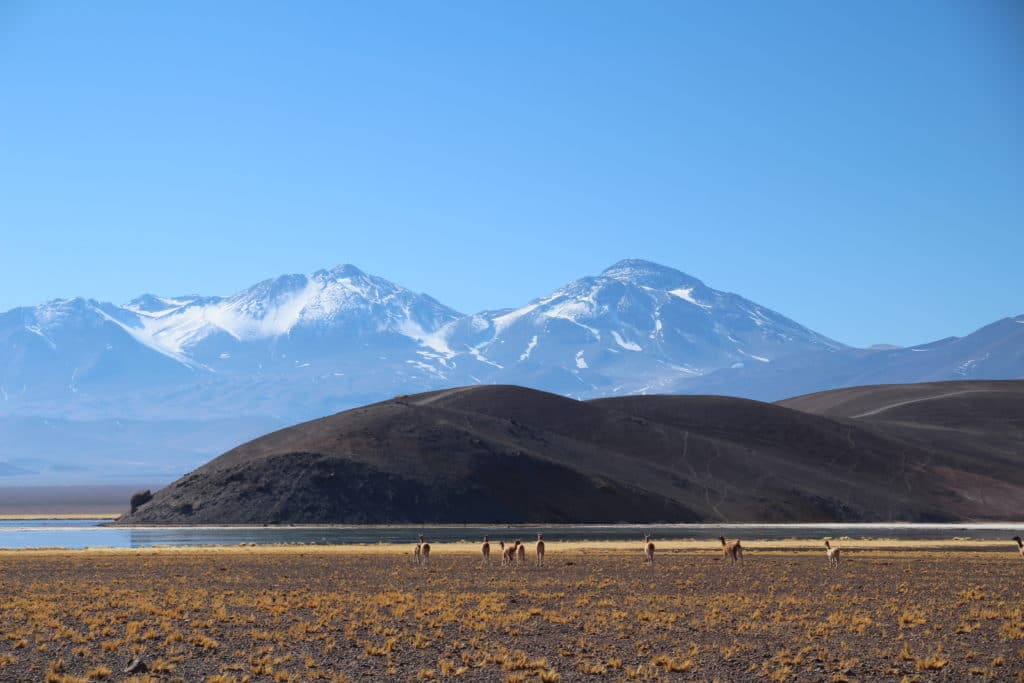We’re back for a blog post focused on Chile off the beaten track.
Are you traveling to Chile and want to discover the country through the locals’ eyes? Are you looking for the best tips for sightseeing away from the crowds? You’ve come to the right place. Today we will introduce you to the best-kept secret of the Altiplano: the Nevado 3 Cruces Park. It is certainly a little difficult to access, but you will be rewarded by the beauty of these spectacular landscapes, all while being completely isolated from the rest of the world. An unforgettable experience is on the program.
Our tips for organizing your trip to Nevado 3 Cruces Park

Nevado 3 Cruces Park? What is it?
If you have never heard of Nevado 3 Cruces Park, the following few lines should convince you to immediately add it to the top of your Chile bucket list.
Located at almost 12,500 feet above sea level, this protected national park is home to a rich ecosystem of more than 70 species. Among the park’s superstars are the 3 species of pink flamingos (the Chilean, the James, and the Andean), the Andes gull, the horned coot, and the pato jergón chico, an endemic duck.
Nevado 3 Cruces Park is composed of two distinct zones: the Laguna Rosa and the area of the Laguna del Negro Francisco. The park also houses one of the highest volcanoes in the world: the Nevado 3 Cruces volcano, whose 3 peaks gave the park its name. They tower at heights of 20, 360 feet, 21,750 feet, and 22,150 feet. The park also permits access to the Ojos del Salado volcano, the second highest peak in Latin America and the highest volcano in the world at 22,600 feet.
Let’s discover the must-see corners of Nevados 3 Cruces Park.
Must sees:
Laguna Rosa

A word of warning: the landscape is breathtaking, literally and figuratively. This lagoon, which is the first that you will encounter arriving by the main road, already sits at more than 12,000 feet above sea level.
Once there, it’s difficult to put words to feelings. The snow-capped peaks of the volcanoes that dominate the lagoon’s backdrop, the pink flamingos frolicking, the total silence and tranquility… All the elements come together to create a magical atmosphere.
Salar de Maricunga

Making your way slowly so as not to run out of steam, we recommend walking to the Salar de Maricunga, which surrounds the Laguna Rosa. It was created by the crossing of the Claudio Gay mountain range and the Domeyko mountain range, which formed a closed basin in which the salt concentrated as the seawater evaporated. Today, its nearly 20,000 acres of area make it (unfortunately) a very attractive site for lithium farms.
Laguna Verde

To the east of the park, on the road that leads to Argentina (towards Paso San Francisco), lies the Laguna Verde. This lagoon, which is actually a mountain salt lake, is located at 14,300 feet above sea level. The very high salinity content of its waters gives it an incredible emerald green color, but restricts any form of life around.
Salar de Pedernales

This salt flat is particularly known for its turquoise pools of water in which you can swim. Landlocked between the mountain ranges of Domeyko and Claudio Gay and located at an altitude of 11,000 feet, the area is also home to flamingos and wild ducks. In addition to a swim in waters with a high salt concentration, which offers the same sensation as floating on the Dead Sea, you will enjoy a moment of relaxation in a unique landscape: in the heart of a desert and surrounded by mountains.
Waterfall and Juncal thermal baths
Located in the middle of a mountainous area, between the Pedernales salt flat (to the north) and Maricunga (to the south), the Juncal thermal baths offer hot water pools between 86ºF and 104ºF. It’s a mini paradise ideal for a well-deserved leisurely soak.
Altitude Sickness: Our Experience
We can’t tell you about Nevado 3 Cruces Park without telling you about altitude sickness. That’s because the park is located between 12,500 feet and 13,800 feet above sea level. The refuge of the Santa Rosa sector, which is the lowest point, is located at 12,500 feet, which is already very high, especially when you don’t have time to naturally acclimatize.
In theory, it is recommended to acclimatize gradually, increasing 1,000 feet per hour. However, since Copiapo is located at less than 3,280 feet in altitude and the refuge at 12,500 feet, it would take you more than 8 hours to get there, which in practice is complicated. Sleeping one night halfway between the two points would be ideal. However, there is no tourist infrastructure before the Laguna Rosa sector. That is why it is likely that climbing in altitude, even going slowly, you will still suffer from some of the evils of altitude sickness once you get to the top.
In any case, that’s what happened to us! To be frank, we didn’t sleep at all that night. If you actively follow our blog, you will remember that the same thing happened to us at the Salar de Surire, another incredible and off-the-beaten-track place, as we talk about in our trip to the Far North.
We therefore recommend that you be extremely careful not to venture there if you know that you easily suffer from altitude sickness. Once there, be careful to walk very slowly, hydrate well, and bring appropriate medications. If you have any concerns, consult a doctor beforehand.
How to get there

The closest town to Nevado 3 Cruces Park is Copiapó. It is also the point of access to reach Pan de Azucar Park and the flowering desert.
To reach Copiapó from Santiago, we recommend an overnight bus, which takes 12 hours. It’s a super convenient way to travel from Santiago as the bus has beds, and it is possible to sleep comfortably.
An alternative is to fly. The fastest, most direct flight will take you to Del Desierto Airport, located 25 miles from Copiapo. From there you can rent a vehicle to then go to the park.
To reach Nevado 3 Cruces, there are two options: car rental and guided tour.
If you opt for a car rental, we advise you to choose a vehicle with 4-wheel drive, although it’s not mandatory if you stay on the trails. Keep in mind that you will be traveling to a secluded park, with no phone service and no facilities. If you choose to go to the Negro Francisco area, you must take your fuel with you, because there is no gas pump in the park, nor on the way.
In addition, you will have to be able to survive independently in case you have a breakdown, are lost, or get stuck with your vehicle. So prepare all the necessary equipment and supplies before your departure (food, drinking water, sleeping bag, warm clothes, etc.). It’s a good idea to always have with you emergency equipment, a map, a GPS, and a compass. Car rental companies will also recommend chains, a shovel, or a winch (in case the vehicle gets stuck in the sand), as well as a radio beacon. We did not carry this additional equipment with us during our visit, but we only went to Laguna Santa Rosa.
It is also essential to inquire about the current weather conditions before leaving, and not to take risks in case of rain or snow.
You must inform CONAF or SERNATUR about where you intend to go and the duration of your stay.
All these logistical complexities prompt us, as a travel agency, to recommend leaving the details of your trip to professionals.
Our recommendations

If you choose to go with a tourist organization, you won’t have to worry about all these safety aspects. Nevertheless, we recommend that you pay attention to altitude acclimatization when choosing your excursion. It is not recommended to choose a single day trip. The best option is to plan to stay 2 days or more in order to see the different sectors and allow your body to adjust. To combine your visit with the Salar de Penernales, it is best to choose an excursion of 3 days and 2 nights.
Discovering the park with a guide not only takes care of the logistical and security details, but also allows you to see places you would not have been able to access alone. Their knowledge of the terrain and their mastery of the vehicle allows them to truly introduce travelers to all the hidden corners of the park.
In addition, the guides are also there to identify the fauna and flora, whose subtleties are not always distinguished (either due to the altitude or the weather and geographical conditions). Finally, the guide allows you to control your acclimatization to the altitude.
When to go
Located between 12,500 feet and 13,800 feet above sea level, the climate is dry and cold. In the high mountain range area, temperatures fluctuate between 37°F and 66°F in summer and 40°F and 5°F in winter. Be careful, though–the wind chill can easily drop to -22° F.
Since the road leading to the park passes through the Argentine border, it is controlled and closed by customs at the first sign of snow. Given the altitude, the risk of snow, and the very low temperatures, it is therefore better to go to the Nevado 3 Cruces during the summer, or in other words, from November to April.
Where to stay

We want to clarify upfront that if you are looking for comfort or romantic accommodations, the Nevado 3 Cruces Park is not the place to find them. There are two accommodation areas in the campsite: a zone on one side of the Laguna Rosa (this is where we slept), and a CONAF refuge on the side of the Laguna Negro Francisco.
The accommodation by the Laguna Santa Rosa is very basic, but it can receive tourists. There are two dormitories with a few beds, a kitchen and a toilet. When we say “basic”: there is no running water; you have to fetch water with a bucket (and sometimes break the ice). Electricity is provided by a solar panel and a backup generator. This center also welcomes guides and can organize tourist excursions if you notify them in advance.
The refuge of the Negro Francisco sector is even more simple, equipped with beds, kitchen, and toilet, but no heating. The water on site is NOT drinkable, so you will have to arrive with full bottles. You will also need to bring your own food because there is nothing available on-site. Don’t forget your 13-gallon jug of gasoline.
As far as equipment goes, you will need to arrive with a very warm sleeping bag (we had a down sleeping bag apt for lows of 22°F and we were still cold), as well as warm, appropriate clothing including base layers. Walking shoes, hat, gloves and scarf are essential, even in summer. We also advise you not to forget your headlamp.
That’s it! We explored all of the information necessary for an adventure in the most secret Altiplano park in Chile. Still have questions? Ask us in the comments, and we will be happy to answer them!
See you soon for new adventures!






